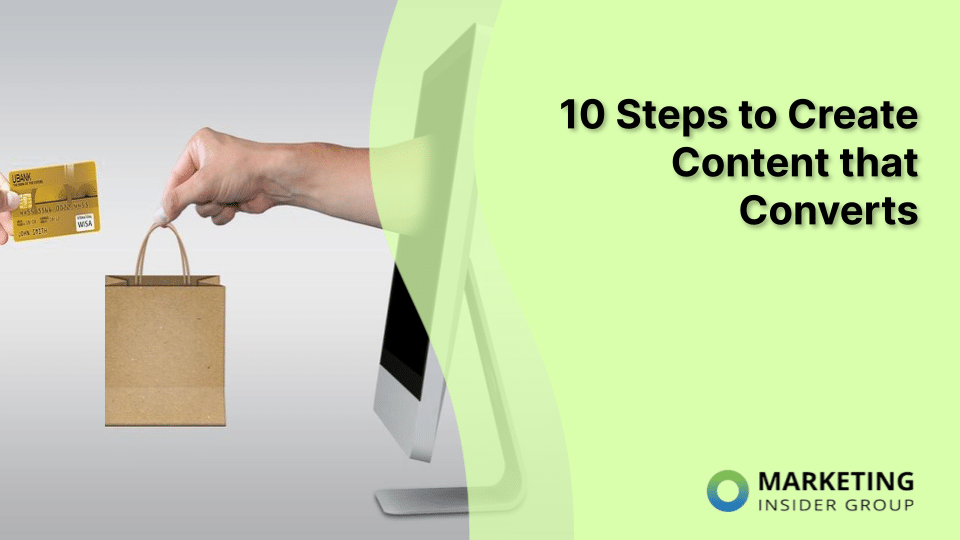
Hopefully, you invest sufficient effort into creating fantastic content that is insightful, helpful, inspiring, or entertaining. However, it’s only worth so much to your brand if it isn’t content that converts.
How can you frame your content in a way that makes your leads more likely to become customers? What is the secret to not just quality content but conversion-worthy content?
Our years of experience with dozens of clients here at Marketing Insider Group have helped us determine the strategies that lead to content that converts. For example, we helped Nutanix expand its reach, boost its podcast’s popularity, and beat industry averages for click-through rate.
Check out the top actionable steps you can apply to your content marketing right now. These tips can help you transform your content into a motivational force your target audience can’t resist.
Key Takeaways:
- Creating content that converts attracts better customers and helps you outperform the competition.
- Start by learning as much as you can about your target audience and understand what you uniquely have to offer them.
- Use attention-grabbing headlines and write scannable content that is easy to read.
- Use imagery and interactive elements to boost conversions.
- Offer lead magnets as content upgrades and monitor your traffic to determine what works best.
Why You Have To Put Even More Attention on Creating Content That Converts
In the prehistoric days of digital marketing, you could publish near gibberish and get traffic as long as you stuffed in enough of a basic keyword. Of course, everyone started noticing the power of online content, and now, one of the first things a business does is set up a website and a blog.
Actually, HubSpot finds that over 80% of marketers now actively use content marketing. That same report shows that the most common metric for the success of content is total sales.
Translation: Everyone is fighting to create content that converts! Therefore, you can’t be random about your content strategy; you need a documented process that you know works.
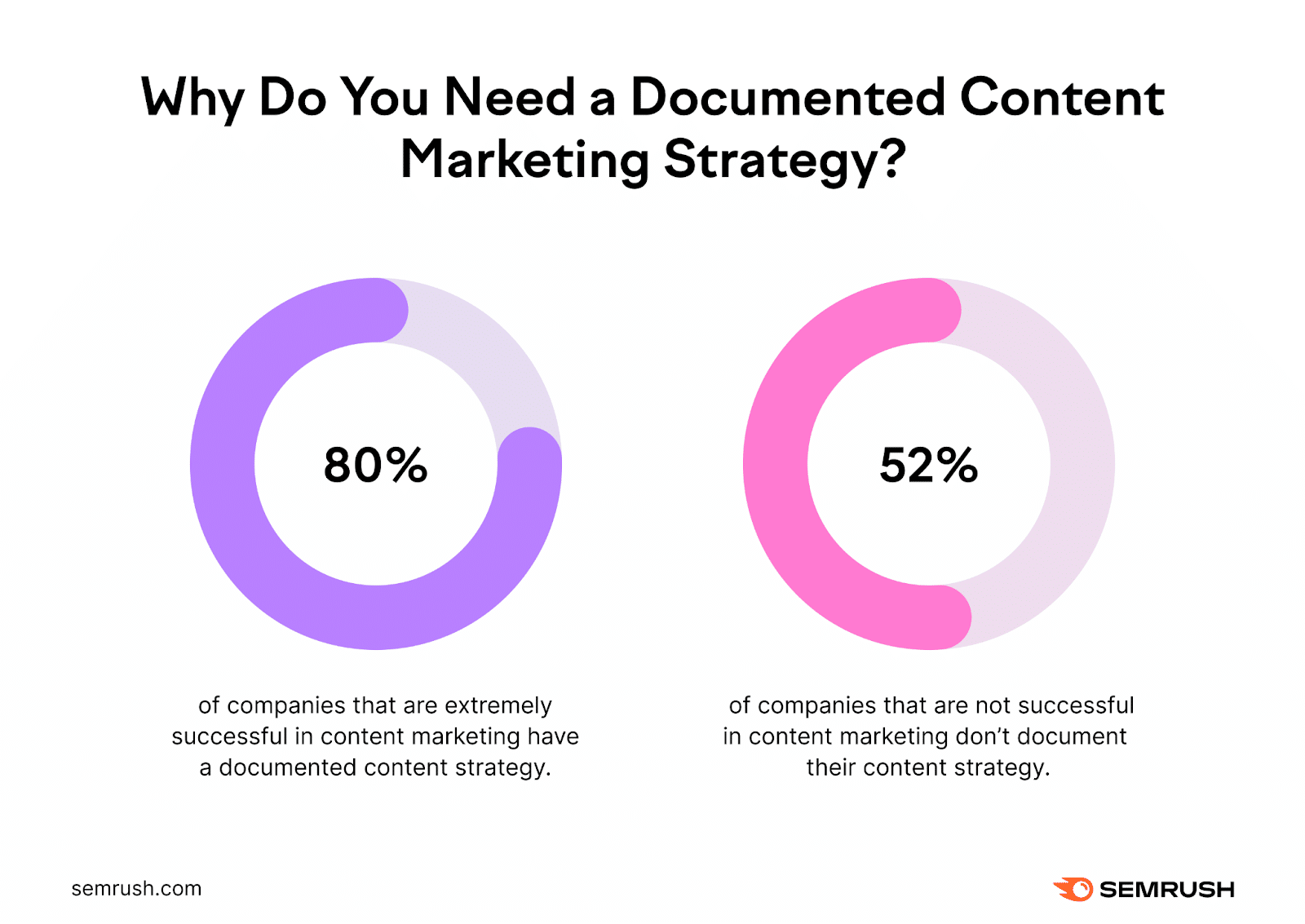
Beyond the stiff competition, effective content marketing supersedes traditional lead generation. Rather, it elevates your campaigns toward demand generation, where you can leverage engaging interactions with your target audience.
The education and entertainment you provide through your content get them excited about your services without an explicit sales pitch. As a result, you attract and create more brand-loyal customers who are less price-sensitive.
10 Steps You Must Follow To Create Content That Converts
Are you ready to start? Test these 10 steps to start generating more conversions from your content!
1. Learn Everything You Can About Your Audience (and Yourself)
Well-founded knowledge is the root of any successful marketing initiative. Key in on the following areas.
Understand Yourself First
Do you really have a vision for what you’re trying to do as a business and how you make the world better? If you’re just in it for money and quick wins, you shouldn’t worry about creating content that converts anyway, because content marketing and SEO are all about long-term success.
You might think that knowing yourself and your business should be easy. Still, if that were the case, why do so many of us need therapy? 
Plus, you can surely recite from memory many companies that lost their appreciation of what their customers come to them for, leading to marketing failures. (Think Bud Light’s disastrous collaboration with Dylan Mulvaney or Pepsi’s Kendall Jenner ad.)
It all goes to illustrate that you have to know who you are and what you’re in the best position to offer. This knowledge helps you hone in on the target market that needs your content and keeps you from wasting time and energy.
Know Who Your Qualified Leads Are
The fact is, only a fraction of your leads are going to become your customers. When you look at the statistics on lead conversion, you can only reasonably expect between 25 and 50% of your leads to ever convert.
Of those qualified leads, only a segment is ready to buy now. The rest need time and varying degrees of warming up to convert.
Knowing this, you have a crucial task if you want to create content that converts for each segment. Do research to discover the questions, interests, needs, and concerns of your qualified leads.
Do this by:
- Investigating your market
- Leveraging your social media and web traffic
- Diving into email marketing analytics
- Using customer feedback surveys
- Simply talking more to your customers and warm leads about what matters to them
Create a lead scoring system that helps you understand where an audience member is in your funnel. Also, continually refine the process to keep your marketing initiatives in line with your audience’s desires.
Discover Which Ideas Are Proven Winners
Sure, figure out the content that converts by trial and error. However, why don’t you look at what’s already working for your competitors and successful marketers and use that to get ahead?
Check out popular blogs in your industry, especially those that are in the same niche as you. One trick is to do an advanced Google search for similar sites to yours by entering “related:yoursite.com”, and you’ll get results for pages that Google says are similar.
You also need to find marketing tools that help you uncover the sites that are ranking on the first page and which keywords are most successful. Beyond finding popular keywords, understand the intent behind them so you can attract the right audience for content that converts.
For example, if you’re a law firm that handles personal injury, you can target people who are searching for “car accidents.” However, you need to make sure you’re finding people who are looking to be plaintiffs in civil cases and not defendants in criminal trials.
You’d also try to eliminate from that crowd people who are simply looking for local news or doing research. Use your martech tools to discover the long-tail keywords that hone in on the right individuals.
Finally, keep an eye out for the types of content that your target audience engages with most. Lean into the content formats that are more likely to convert.
2. Attract Leads With Attention-Grabbing Headlines
Before you can convert anyone with your content, you have to get them to open it first. Don’t give short shrift to your headlines by leaving them as an afterthought.
This step is all the more crucial with the abundance of content out there. So, do what you can to create content that converts using the following tips when fitting:
- Concisely tell your readers what they will gain from your article in under 60 characters.
- Include numbers to indicate a list.
- Use emotional language.
- Insert a time-based element with words like “now,” “today,” and “immediately.”
Don’t cram these in every headline, but figure out when they’re practical to employ.
More About Using Numbers
To go further on these suggestions, recognize that specific numbers get more attention than others. In particular, try those with cultural significance or a sense of symmetry and “roundness.”
For example, who doesn’t feel attracted to “lucky 7”? 12 and 24 can cultivate an implicit sense of time and urgency.
Naturally, the number 10 is everyone’s favorite (see our headline above  ), but other numbers that end in 5 or 0 perform well. Interestingly, odd numbers tend to perform better than even ones, probably because they seem more specific.
), but other numbers that end in 5 or 0 perform well. Interestingly, odd numbers tend to perform better than even ones, probably because they seem more specific.
Whatever the case, use more digits in headlines to attract people.

Bonus Tip on Inciting Emotions
Negative emotions seem to get more traction than positive ones in content that converts. Again, that’s probably because people get a glut of advertisements that talk about how great a product or service is and like it when a piece “keeps it real.”
Try using articles that tell people to stop doing something or the types of things they need to avoid. We often use that tactic here with snarky content, such as my book “Mean People Suck” and the blog “8 Common Sales Mistakes That Need to Stop NOW.”
3. Write Readable and Scannable Content
You’re probably writing articles on your laptop or PC, but people are reading them most often on mobile devices. Design your content with that thought in mind.
Content that converts leaves lots of white space using wide margins, double spacing, and short paragraphs. The image below shows how dense text compares to more readable content. Which one looks more appealing to you?
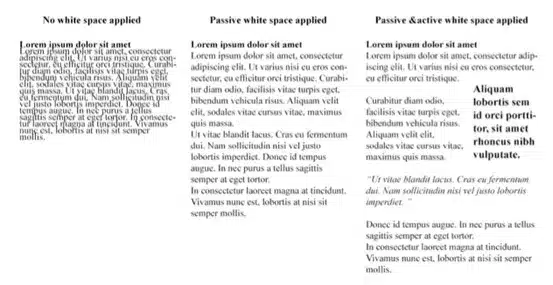
For your actual writing, break things up so anyone can easily digest it. People are on the go and trying to multitask, so let your message smack them in the face with its clarity (in a friendly way, of course!  )
)
Start with short sentences in active voice. Try using a tool like Hemingway Editor to find out the reading level. Experts find that Grade 8 is usually the sweet spot.
Particularly for longer articles, use lots of subheadings, bullets, and numbered lists to break things up for readability. Block quotes can be effective for a key point or two you want to stand out.
One more tip that we’ve fully embraced at MIG recently is adding tables of content with jump links. While readers love to click on longer blogs, they only dig deep into what pertains to them and scan the rest.
A linked table of contents helps them find what they need more easily. And easy-to-read pages equal content that converts.
4. Be Personable and Conversational
There’s no need to get highfalutin to create content that converts. As Seth Godin said over a decade ago, “Write like you talk.”
You’re not here to impress. You’re just trying to help people solve problems.
One way to improve is to imagine you were sitting down for a cup of coffee with the reader and explaining what you do for a living. Bingo. That’s how you write content that converts.
That also means avoiding industry jargon. However, if you have to use unique terms for specificity, explain them or link to more info if your audience will be unfamiliar with the vocabulary.
Of course, don’t get sloppy or write in a stream-of-consciousness style. Just find a system that helps you organize your thoughts and write with personality. Then, keep at it and you’ll improve.
5. Make Your Content More Visually Appealing and Interactive
When you were a kid, did you prefer straight text or pop-up books, coloring books, and games? Likewise, content that converts gets as colorful, interactive, and fun as possible for the medium.
For starters, always include a few images at a minimum. One should open your articles, and others can illustrate points along the way.
(For example, consider the point about white space above. It’s much clearer when you can see what that looks like.)
Also, don’t just throw in stock photos to have pictures around. Share something of value.
Whether creating your own or sharing from another source, find images of good quality that won’t give readers a headache to look at. Moreover, don’t forget alt text that helps readers with accessibility needs and improves your SEO.
Keep the same points in mind for videos. Link to YouTube videos that teach your point or create your own if practical.
If you really want to activate boss mode, add interactive elements. These can include:
- Infographics
- Games
- Quizzes
- Polls
- Calculators
For example, Intermedia helps readers determine how much money they’ll save with an online calculator for its contact center software.
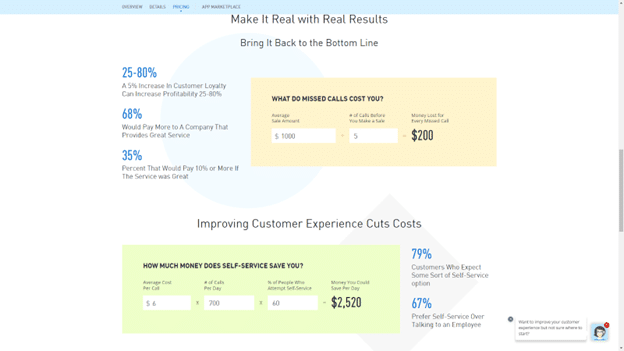
6. Make Your Unique Value Proposition More Unique
Granted, you don’t want to be too salesy. However, your goal is still to create content that converts, so you don’t have to tiptoe around the fact that you’re selling something.
In many ways, your content pages can imitate landing pages that use the LIFT model. The six elements of the LIFT strategy include:
- A unique value proposition that defines a specific problem that your audience has and offers an actionable solution
- A sense of urgency, such as you could use in a headline or CTA with time-based wording
- Subject matters with relevance to your audience segment
- Clarity in the messaging
- Attention to your audience’s anxiety by discussing their pain points
- Distraction-free pages with readability and white space
As you can see, you can fulfill the latter five points through other tactics we mention in this 10-step list for content that converts. However, you need to give special attention to your unique value proposition.
The problem with a lot of value propositions is they are too generic. Your UVP should concisely explain how your brand solves your customers’ problems.
Additionally, it needs to demonstrate why your business is different than every other provider out there. Consider if your UVP meets these objectives or needs a refresh, update, or rewrite.
To give your UVP a makeover, there are different approaches you can take, depending on the personality of your brand and your target audience:
- Include statistics
- Use more “power” words
- Pare it down to a simpler message
- Ask a question
- Use active verbs when mentioning your product or services
Here’s an excellent example from CrazyEgg that does it all. It’s engaging, clean, and conversational:
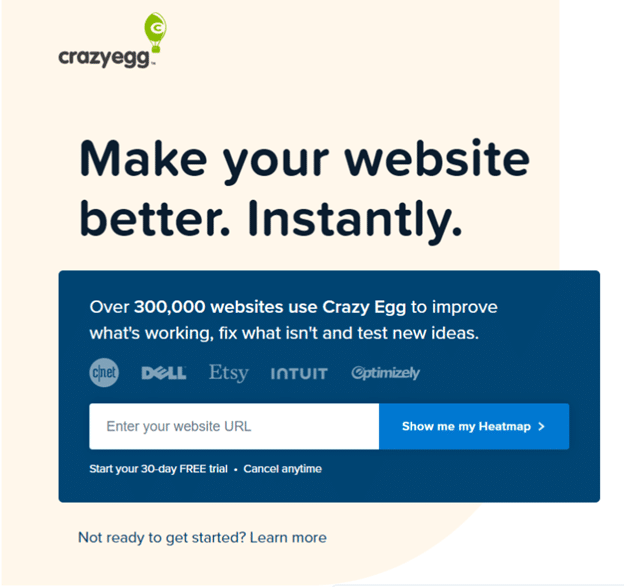
This same messaging reverberates throughout their website in content that converts.
Once you’ve redone your UVP, use it to tailor your content offerings. Now you aren’t just any old brand that offers “quality services” but one that provides a particular offering with tangible results that your audience can get excited about.
7. Use More Than Blogs To Generate Content That Converts
We reference blogging most often for content that converts because that’s what we do and what we’re experts at here at MIG. However, you can (and should) go beyond blog pages and even written content.
To increase conversions, you need a dynamic content marketing strategy that seamlessly compels your audience down the sales funnel. The content on your blog can be an excellent starting point for increasing interest, educating your audience, and establishing your brand as a thought leader.
You’ll need to excel at other content channels that can do even more to motivate your potential buyers further along, such as:
- White papers
- How-to videos
- Industry cheat sheets and guides
- Insightful ebooks
- Podcasts
Develop a well-thought-out strategy to make these formats serve as content that converts.
For example, you can craft them as follow-ups or more in-depth versions of your blogs and infographics. Design them to build off one another, giving your qualified leads an experience that is an ongoing journey from one guide post to the next.
In fact, you should offer some of them as lead magnets that are content upgrades. This is a great way to get more conversions and build your email list.
8. Create Emotionally-Charged CTAs
We mentioned this point with headlines, and it applies doubly to your calls to action. Remember that as logical as people think that they are, everyone essentially buys due to emotion more than reason (even in B2B).
Even when logic is in the process, a person will turn to you because of how you make them feel. Surely, you remember a time when you’ve not shopped at a store or avoided a vendor with a great product because they were total jerks.
Start by inserting CTAs at points where you’ve stoked your audience’s emotions. When they would naturally be wondering how to learn more or move forward, content that converts invites them to take that step.
For buyers progressing through the funnel, that might be opening a link to another piece of content, subscribing to a list, or finally making a purchase. (Yay!  )
)
At the same time, use language that tells the reader how they’ll feel or what they’ll experience after taking the action. For example, you could say, “Join the fun” or “Call our firm to start fighting for justice now.”
Get better at writing with genuine emotion by developing more empathy for your customers. This empathy map can guide you to speak to their concerns:
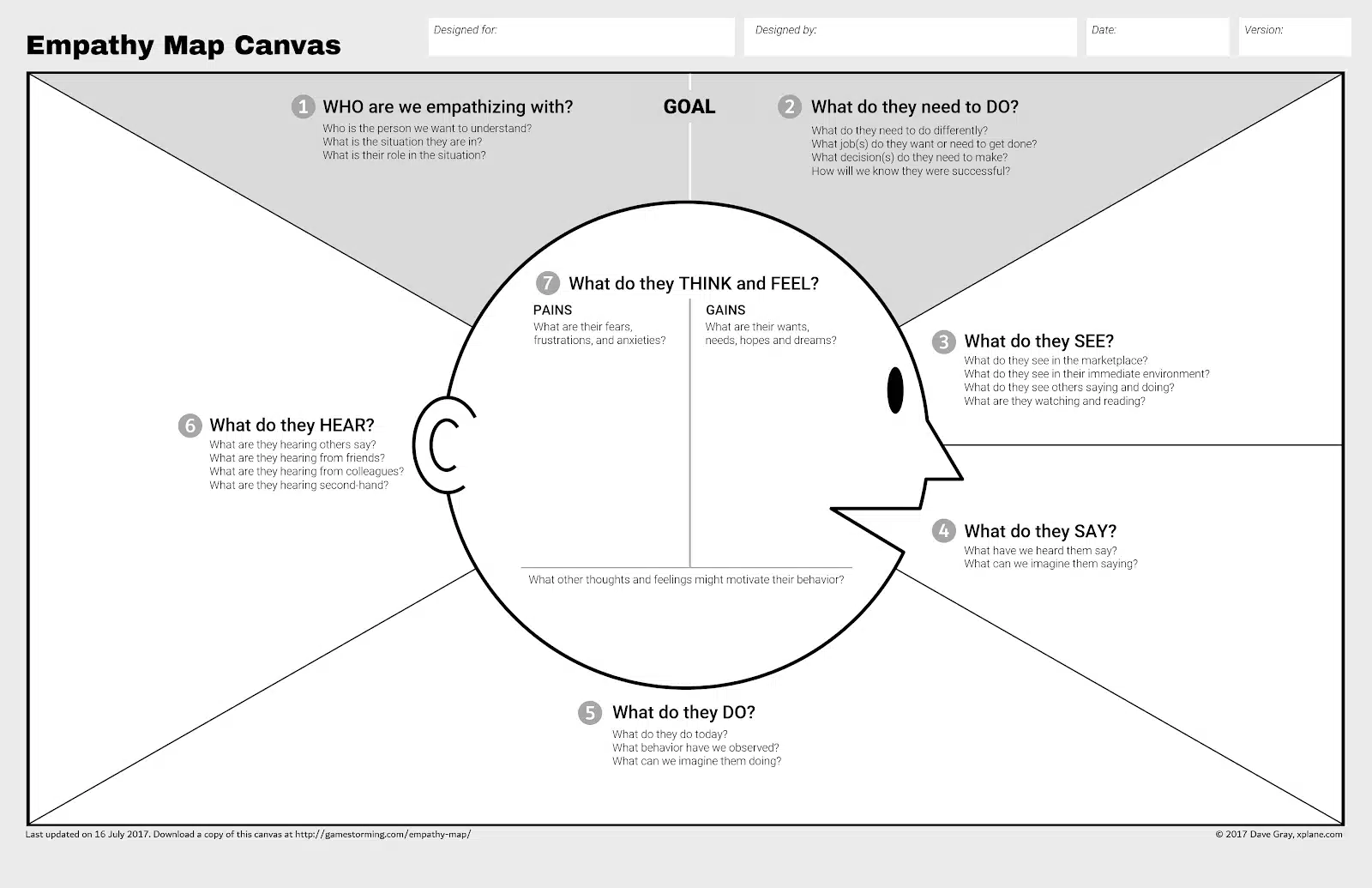
9. Bring In Other Voices for Social Proof
Look for ways to toss in endorsements and testimonials as social proof in your content, whether through hyperlinks, direct quotes, or stories. Since you’re educating your audience with real data, don’t be afraid to show how you’ve helped someone.
Another way to get content that converts on your blog is to bring in other voices through guest posts. You’ll add variety to your library and fresh viewpoints. Plus, you’ll draw a larger audience as followers of the guest blogger come to your site.
10. Track Your Content With the Right Metrics
The final step to creating content that converts is to pay attention to what it’s doing in real time. Ask yourself and your team:
- What blog formats or video topics are leading to more sales?
- How much of a difference does it make when posting a how-to video on the landing page?
- What happens to sales when you change the personality of your promotional video, for example, from professional to casual?
Discover the metrics that matter to your bottom line and follow those most closely.
True, good content will almost always yield increasing website traffic and social media engagement. However, these metrics can be distracting.
With content marketing, too often we lose track of the end-game goals in favor of the more easy-to-acquire vanity metrics. In fact, many marketers still report that they find it a challenge to organize data or don’t even know what to measure.
The real revenue-driving, meaty goals of your marketing strategy are customer acquisition and retention, not your bounce rate and Facebook likes. Pay attention to what motivates your leads the most to acquire a wealth of feedback that helps you always publish content that converts.

Call MIG To Start Immediately Generating Content That Converts
You don’t have to stumble around on your own to figure out the formula for content that converts. We’re ready over here at MIG to give you a helping hand.
Talk to us today about our Content Builder Services that guarantee you even more content that converts.
0 Commentaires